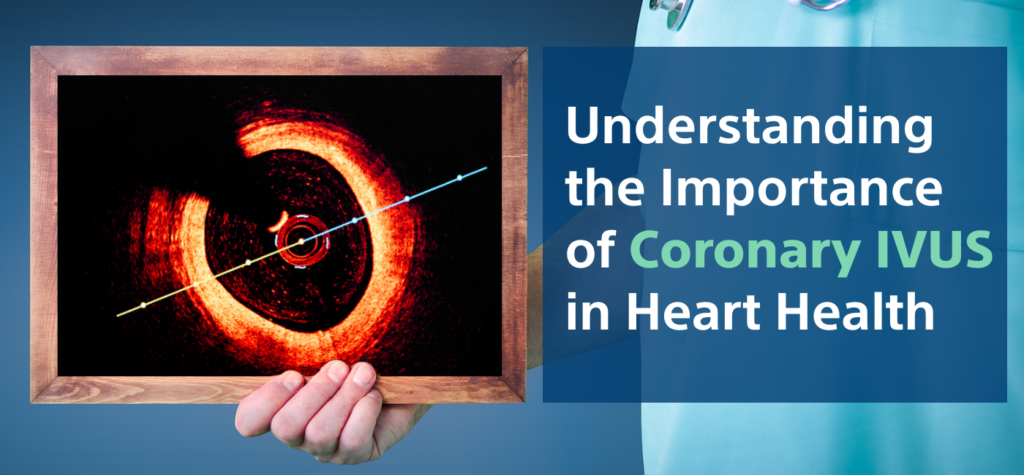Heart health is a vital aspect of complete well-being. With advancements in medical technology, various tools and procedures have emerged to diagnose and treat heart conditions more effectively. One such innovative tool is Coronary Intravascular Ultrasound (IVUS).
This technology plays a significant role in understanding and managing heart health, particularly concerning detecting and treating blockages in the coronary arteries. This article delves into the importance of Coronary IVUS in maintaining heart health and highlights the symptoms and risks associated with heart blockages.
Exploring the Importance of Coronary IVUS
Coronary IVUS is a valuable tool in cardiology. It provides a detailed view of the inside of the coronary arteries that source blood to the heart muscle. Using high-frequency sound waves, IVUS creates images that help doctors see the extent and nature of blockages or plaques within the arteries.
One significant importance of Coronary IVUS is its ability to provide accurate measurements of the arterial walls and the composition of the plaques. This detailed information allows for better decision-making when it comes to treatment options. Doctors can determine whether a blockage is severe enough to require a stent or if other interventions are necessary.
Heart Blockage Symptoms: Early Detection is Key
Recognizing heart blockage symptoms is essential for early intervention and treatment. The most common signs include chest pain/discomfort, shortness of breath, fatigue, and dizziness. Sometimes, these symptoms are mistaken for other conditions, so an accurate diagnosis is vital.
IVUS can help detect blockages early, even before symptoms become severe. This technology allows for a complete examination of the coronary arteries, identifying areas at risk of becoming fully occluded. Early detection through IVUS can lead to timely treatments that prevent more severe complications.
The Process and Benefits of Coronary IVUS
Coronary IVUS involves inserting a catheter with an ultrasound probe into the coronary arteries. This procedure is typically performed during cardiac catheterization. As the probe moves through the arteries, sound waves bounce off the arterial walls and return to the probe. These sound waves create detailed images that are displayed on a monitor.
One of the critical benefits of IVUS is its ability to provide real-time, high-resolution images. These images offer a clearer picture of the condition of the arteries compared to traditional angiography alone. This precise imaging helps doctors tailor treatments to the patient’s specific needs, improving outcomes.
Managing Occluded Arteries with IVUS
An artery is considered occluded when blocked or severely narrowed, restricting blood flow to the heart. The use of IVUS in managing occluded arteries is crucial. By providing detailed images of the blockage, IVUS allows doctors to comprehend the extent of the occlusion and its composition. This information is vital in influencing the most effective treatment approach.
For example, if a blockage is due to soft plaque, it might be treated with medication or lifestyle changes. However, if the blockage is due to complex, calcified plaque, a stent may be necessary to open the artery. The precise images provided by IVUS help doctors make these critical decisions.
Enhancing Treatment Decisions with IVUS
The importance of Coronary IVUS extends to its role in guiding treatment decisions during procedures such as angioplasty and stent placement. During angioplasty, a balloon opens a narrowed artery, and a stent is often placed to keep the artery open. IVUS provides real-time feedback during these procedures, ensuring the stent is positioned correctly, and the artery is appropriately expanded.
This guidance is essential in complex cases where the anatomy of the artery may be challenging. By using IVUS, doctors can achieve better results, reducing the risk of complications and enlightening long-term patient outcomes.
Preventing Further Heart Complications
Heart blockages can lead to severe complications such as heart attacks or heart failure if left untreated. Recognizing “heart blockage symptoms” early and using tools like IVUS for accurate diagnosis and treatment can prevent these complications. The detailed imaging provided by IVUS allows for targeted therapies that address the specific cause of the blockage, reducing the risk of further issues.
In addition to its diagnostic capabilities, IVUS can also be used to monitor treatment success over time. By regularly assessing the arteries’ condition, doctors can adjust behavior plans as needed, ensuring patients receive the best care.
The Role of IVUS in Modern Cardiology
Modern cardiology has dramatically benefited from the introduction of IVUS. The importance of Coronary IVUS lies in its ability to provide detailed, accurate information about the condition of the coronary arteries. This information is crucial for diagnosing and treating heart conditions effectively.
IVUS has become an integral part of cardiac care, helping improve outcomes for coronary artery disease patients. By providing detailed images of the arteries, IVUS allows for more precise and targeted treatments, reducing the risk of complications & improving long-term health.
Addressing Common Heart Blockage Symptoms
Understanding and addressing heart blockage symptoms is vital for maintaining heart health. Indications such as chest pain, shortness of breath, and fatigue should not be ignored, as they can indicate the presence of blockages in the coronary arteries. Early detection & treatment are crucial to preventing serious complications.
IVUS plays a crucial role in diagnosing the cause of these symptoms. IVUS helps doctors identify the presence and extent of blockages by providing detailed images of the arteries. This evidence is vital for developing effective treatment plans that address the primary cause of the symptoms.
Improving Patient Outcomes with IVUS
The use of IVUS in diagnosing and treating heart conditions has significantly improved patient outcomes. The “Importance of Coronary IVUS” is evident in its ability to provide detailed, accurate information that guides treatment decisions. By using IVUS, doctors can achieve better results, reducing the risk and improving long-term health for patients.
For patients with coronary artery disease, IVUS offers a valuable tool for managing their condition. The detailed images provided by IVUS allow for more precise and targeted treatments, improving outcomes and reducing the risk of further complications.
Conclusion
Coronary IVUS has revolutionized cardiology, offering a valuable tool for diagnosing and treating heart conditions. The “Importance of Coronary IVUS” lies in its ability to provide detailed, accurate information about the condition of the coronary arteries. This information is crucial for diagnosing and treating heart conditions effectively, improving patient outcomes, and reducing the risk of complications.
Understanding and addressing heart blockage symptoms early is essential for maintaining heart health. Indications such as chest pain, shortness of breath, and fatigue should not be ignored, as they can indicate the presence of blockages in the coronary arteries. Initial detection and treatment are crucial to preventing serious complications.
IVUS plays a crucial role in diagnosing the cause of these symptoms and guiding treatment decisions. The detailed images provided by IVUS allow for targeted treatments that address the specific cause of the blockage, improving patient outcomes and reducing the risk of further complications.
IVUS is essential in managing occluded arteries, as it provides detailed images that help doctors understand the extent and composition of the blockage. This information is vital for determining the most effective treatment approach, improving patient outcomes, and reducing the risk of complications.
Read more blogs click here.




